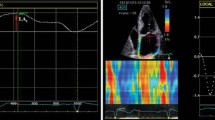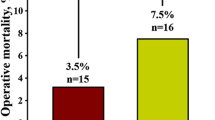Abstract
Pulmonary hypertension (PHT) is not uncommon in patients with aortic stenosis (AS) and portends a dismal prognosis. We attempted to determine the prevalence of PHT and to identify contributors to its development in patients with moderate or severe AS. A total of 189 patients were enrolled. Patients were divided into two groups according to the presence or absence of PHT, with a pulmonary artery systolic pressure cutoff value of 40 mmHg. Left ventricular (LV) systolic function was assessed by global longitudinal (LV-GLS), circumferential (LV-GCS) and radial (LV-GRS) strains on top of LV ejection fraction (LV-EF). The ratio of mitral E to septal mitral annular e′ velocity (E/e′) was calculated to estimate LV filling pressure. Fifty patients (26.5 %) had concomitant PHT. Patients with PHT had a higher prevalence of diabetes, a lower LV-EF, a higher E/e′, a larger left atrial volume index, a smaller indexed aortic valve (AV) area, and a more reduced LV-GLS (all p < 0.05). However, LV-GRS and LV-GCS were similar in patients with or without PHT. On multivariate logistic regression analysis, LV-GLS and E/e′ were independently associated with PHT, whereas LV-EF and indexed AV area were not. PHT complicating moderate or severe AS is commonly found and is independently associated with systolic and diastolic dysfunction assessed by Doppler and strain imaging, but not with LV-EF.



Similar content being viewed by others
References
Silver K, Aurigemma G, Krendel S et al (1993) Pulmonary artery hypertension in severe aortic stenosis: incidence and mechanism. Am Heart J 125:146–150
Malouf JF, Enriquez-Sarano M, Pellikka PA et al (2002) Severe pulmonary hypertension in patients with severe aortic valve stenosis: clinical profile and prognostic implications. J Am Coll Cardiol 40:789–795
Casaclang-Verzosa G, Nkomo VT, Sarano ME et al (2008) E/Ea is the major determinant of pulmonary artery pressure in moderate to severe aortic stenosis. J Am Soc Echocardiogr 21:824–827
Kapoor N, Varadarajan P, Pai RG (2008) Echocardiographic predictors of pulmonary hypertension in patients with severe aortic stenosis. Eur J Echocardiogr 9:31–33
Mutlak D, Aronson D, Carasso S et al (2012) Frequency, determinants and outcome of pulmonary hypertension in patients with aortic valve stenosis. Am J Med Sci 343:397–401
Weidemann F, Jamal F, Kowalski M et al (2002) Can strain rate and strain quantify changes in regional systolic function during dobutamine infusion, B-blockade, and atrial pacing–implications for quantitative stress echocardiography. J Am Soc Echocardiogr 15:416–424
Greenberg NL, Firstenberg MS, Castro PL et al (2002) Doppler-derived myocardial systolic strain rate is a strong index of left ventricular contractility. Circulation 105:99–105
Shahul S, Rhee J, Hacker MR et al (2012) Subclinical left ventricular dysfunction in preeclamptic women with preserved left ventricular ejection fraction: a 2D Speckle-Tracking Imaging Study. Circ Cardiovasc Imaging 5:734–739
Bonow RO, Carabello BA, Chatterjee K et al (2008) American College of Cardiology/American Heart Association Task Force on Practice Guidelines. 2008 focused update incorporated into the ACC/AHA 2006 guidelines for the management of patients with valvular heart disease: a report of the American College of Cardiology/American Heart Association Task Force on Practice Guidelines (Writing Committee to revise the 1998 guidelines for the management of patients with valvular heart disease). Endorsed by the Society of Cardiovascular Anesthesiologists, Society for Cardiovascular Angiography and Interventions, and Society of Thoracic Surgeons. J Am Coll Cardiol 52:e1–e142
Quiñones MA, Otto CM, Stoddard M et al (2002) Doppler quantification task force of the nomenclature and standards committee of the American Society of Echocardiography. Recommendations for quantification of Doppler echocardiography: a report from the Doppler quantification task force of the nomenclature and standards committee of the American Society of Echocardiography. J Am Soc Echocardiogr 15:167–184
Bossone E, D’Andrea A, D’Alto M et al (2013) Echocardiography in pulmonary arterial hypertension: from diagnosis to prognosis. J Am Soc Echocardiogr 26:1–14
Nagueh SF, Appleton CP, Gillebert TC et al (2009) Recommendations for the evaluation of left ventricular diastolic function by echocardiography. Eur J Echocardiogr 10:165–193
Sohn DW, Chai IH, Lee DJ et al (1997) Assessment of mitral annulus velocity by Doppler tissue imaging in the evaluation of left ventricular diastolic function. J Am Coll Cardiol 30:474–480
Bruch C, Stypmann J, Grude M et al (2004) Tissue Doppler imaging in patients with moderate to severe aortic valve stenosis: clinical usefulness and diagnostic accuracy. Am Heart J 148:696–702
Lee SP, Kim YJ, Kim JH et al (2011) Deterioration of myocardial function in paradoxical low-flow severe aortic stenosis: two-dimensional strain analysis. J Am Soc Echocardiogr 24:976–983
Reisner SA, Lysyansky P, Agmon Y et al (2004) Global longitudinal strain: a novel index of left ventricular systolic function. J Am Soc Echocardiogr 17:630–633
Cho GY, Marwick TH et al (2009) Global 2-dimensional strain as a new prognosticator in patients with heart failure. J Am Coll Cardiol 54:618–624
Mor-Avi V, Lang RM, Badano LP et al (2011) Current and evolving echocardiographic techniques for the quantitative evaluation of cardiac mechanics: ASE/EAE consensus statement on methodology and indications endorsed by the Japanese Society of Echocardiography. Eur J Echocardiogr 12:167–205
Lam CS, Borlaug BA, Kane GC et al (2009) Age-associated increases in pulmonary artery systolic pressure in the general population. Circulation 119:2663–2670
Faggiano P, Antonini-Canterin F, Ribichini F et al (2000) Pulmonary artery hypertension in adult patients with symptomatic valvular aortic stenosis. Am J Cardiol 85:204–208
Yingchoncharoen T, Gibby C, Rodriguez LL et al (2012) Association of myocardial deformation with outcome in asymptomatic aortic stenosis with normal ejection fraction. Circ Cardiovasc Imaging 5:719–725
Delgado V, Tops LF, van Bommel RJ et al (2009) Strain analysis in patients with severe aortic stenosis and preserved left ventricular ejection fraction undergoing surgical valve replacement. Eur Heart J 30:3037–3047
Hurlburt HM, Aurigemma GP, Hill JC et al (2007) Direct ultrasound measurement of longitudinal, circumferential, and radial strain using 2-dimensional strain imaging in normal adults. Echocardiography 24:723–731
Ozkan A, Kapadia S, Tuzcu M et al (2011) Assessment of left ventricular function in aortic stenosis. Nat Rev Cardiol 8:494–501
Kearney LG, Lu K, Ord M et al (2012) Global longitudinal strain is a strong independent predictor of all-cause mortality in patients with aortic stenosis. Eur Heart J Cardiovasc Imaging 13:827–833
Ng AC, Delgado V, Bertini M et al (2011) Alterations in multidirectional myocardial functions in patients with aortic stenosis and preserved ejection fraction: a two-dimensional speckle tracking analysis. Eur Heart J 32:1542–1550
Hess OM, Villari B, Krayenbuehl HP (1993) Diastolic dysfunction in aortic stenosis. Circulation 87(5 Suppl.):IV73–IV76
Chang SA, Park PW, Sung K et al (2010) Noninvasive estimate of left ventricular filling pressure correlated with early and midterm postoperative cardiovascular events after isolated aortic valve replacement in patients with severe aortic stenosis. J Thorac Cardiovasc Surg 140:1361–1366
Mullens W, Borowski AG, Curtin RJ et al (2009) Tissue Doppler imaging in the estimation of intracardiac filling pressure in decompensated patients with advanced systolic heart failure. Circulation 119:62–70
Dalsgaard M, Kjaergaard J, Pecini R et al (2009) Left ventricular filling pressure estimation at rest and during exercise in patients with severe aortic valve stenosis: comparison of echocardiographic and invasive measurements. J Am Soc Echocardiogr 22:343–349
Lancellotti P, Magne J, Donal E et al (2012) Determinants and prognostic significance of exercise pulmonary hypertension in asymptomatic severe aortic stenosis. Circulation 126:851–859
Acknowledgments
This study was supported by Handok Pharm Research fund 2014.
Conflict of interest
We declare that we have no conflicts of interest except for the following; J.K. Oh is involved in Echo Core Lab work for Core Valve clinical trials in the US.
Author information
Authors and Affiliations
Corresponding author
Rights and permissions
About this article
Cite this article
Ahn, HS., Chang, SA., Kim, HK. et al. Determinants of pulmonary hypertension development in moderate or severe aortic stenosis. Int J Cardiovasc Imaging 30, 1519–1528 (2014). https://doi.org/10.1007/s10554-014-0498-5
Received:
Accepted:
Published:
Issue Date:
DOI: https://doi.org/10.1007/s10554-014-0498-5




